Workflow Rules are automated processes to send E-mails alerts, assign tasks, update fields on trigger criteria based requirements. Salesforce Workflow automation is all about automating the business processes in Salesforce to reduce manual work and make efficient.
In Salesforce, workflow automation enables you to automate standard internal procedures and processes like deal approvals, contract reviews, customer onboarding etc. which can help you in maintaining a set of standards for data quality by automating the business rules and streamlining programmatic emails that are sent to users with just one instruction. Workflow Rules, Process Builder — Flows and Approval Processes to achieve this automation.
Creating a new rule in Salesforce Workflow Automation

- Setup -> Create -> Workflow & Approvals -> Workflow Rules.
- Click on New Rule on Workflow rules.
- Select object which you want this workflow rule to apply.
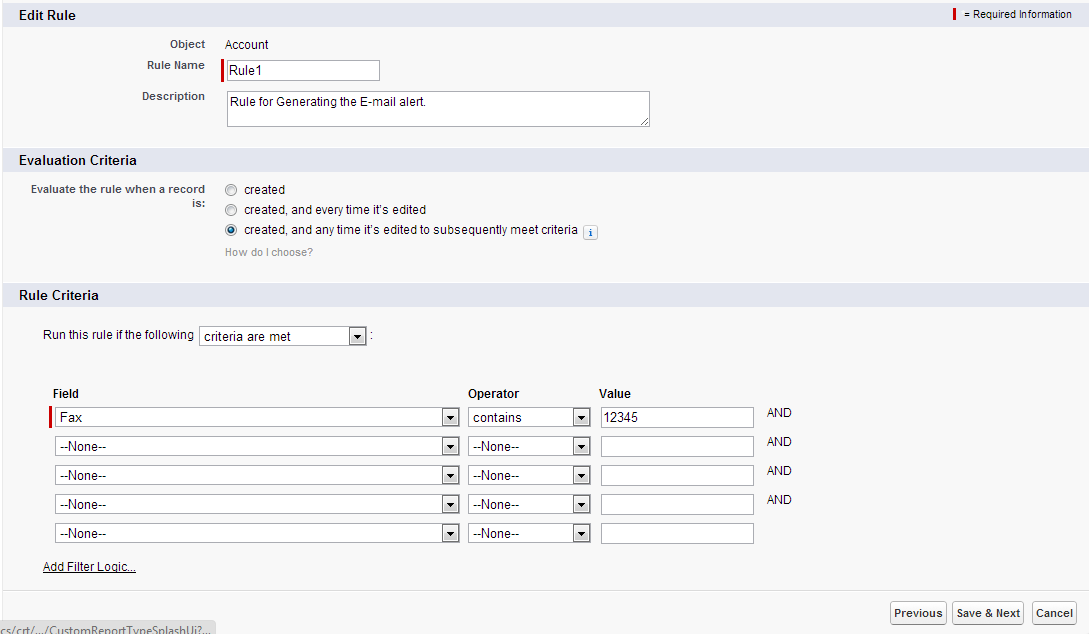
2) Clcik on ‘Next’.
- Enter a rule name.
- Enter a description for the rule.
- Set the evaluation criteria
Created
Evaluate the rule criteria each time a record is created. If the rule criteria is met, run the rule. Ignore all updates to existing records.With this option, the rule never runs more than once per record.
Created, and every time it’s edited
Evaluate the rule criteria each time a record is created or updated. If the rule criteria is met, run the rule. With this option, the rule repeatedly runs every time a record is edited, as long as the record meets the rule criteria.
Created, and any time it’s edited to subsequently meet criteria
Evaluate the rule criteria each time a record is created or updated.
- For a new record, run the rule if the rule criteria is met.
- For an updated record, run the rule only if the record is changed from not meeting the rule criteria to meeting the rule criteria.
Enter your rule criteria
Run this rule if the following according to the criteria based on requirements.
- Criteria are met: Select the filter criteria that a record must meet to trigger the rule.
- Formula evaluates to true: Enter a formula that returns a value of “True” or “False.” Salesforce triggers the rule if the formula returns “True.”
3) Click on Save& Next.
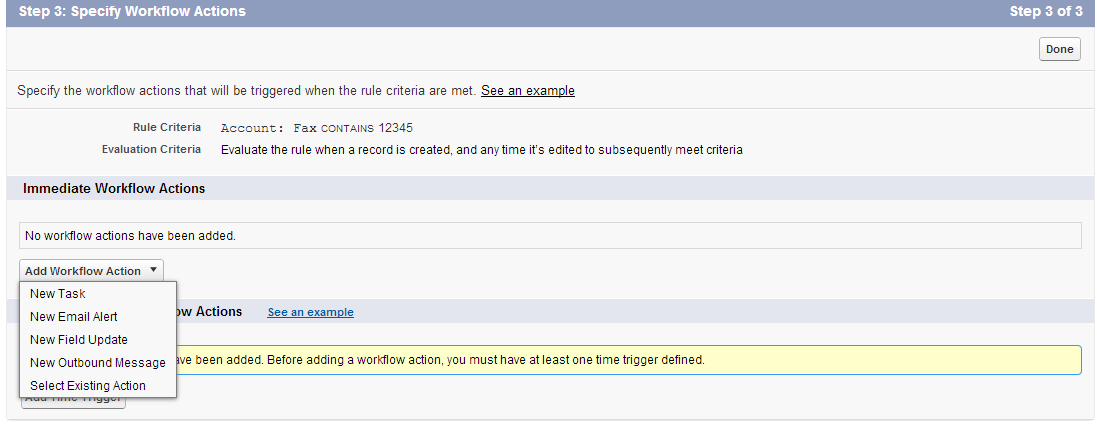
Possible workflow Actions for immediate workflow action:
New Task to create a task to associate with the rule
Create a task to associate with one or more workflow rules, approval processes, or entitlement processes. When changing a task, any modifications will apply to all rules, approvals, or entitlement processes associated with it.
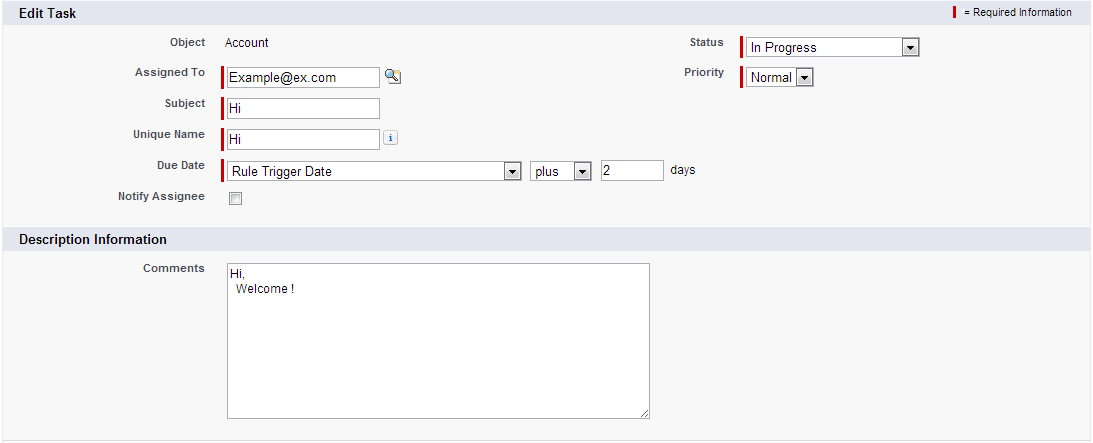
New Email to create an email alert to associate with the rule
Create an email alert to associate with one or more workflow rules, approval processes, or entitlement processes. When changing an email alert, any modifications will apply to all rules, approvals, or entitlement processes associated with it.
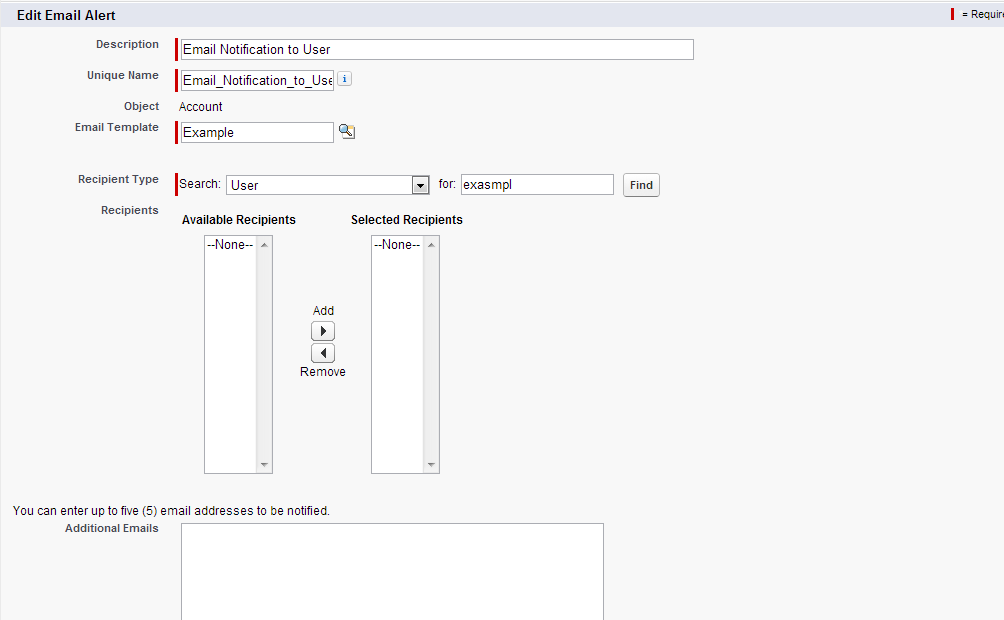
New Field Update to define a field update to associate with the rule
Define the field update, including the object associated with the workflow rule, approval process, or entitlement process, the field to update, and the value to apply. Note that the field to update may be on a related object. Fields are shown only for the type that you select.
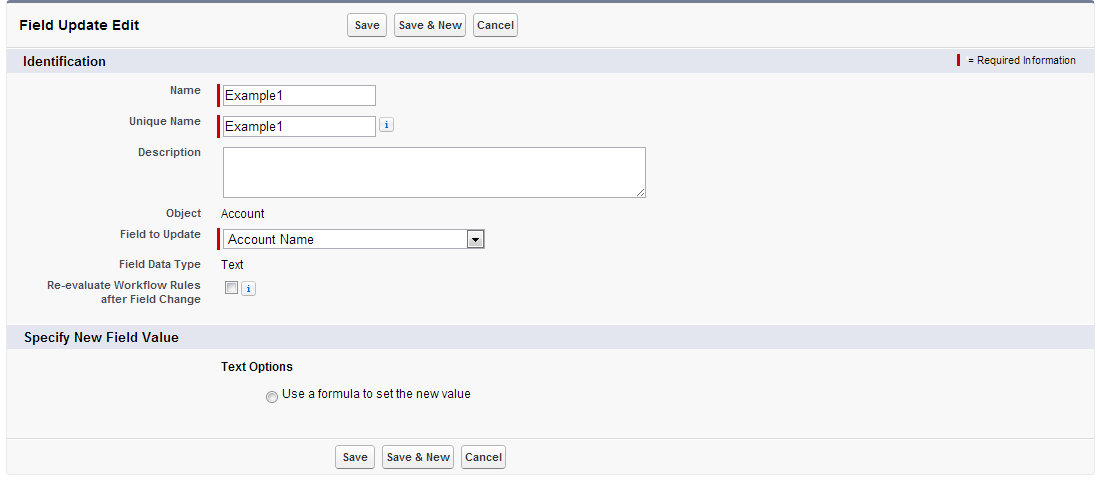
New Outbound Message to define an outbound message to associate with the rule
Enter the details of your outbound message and select the fields you want included in this message. Note that the fields available depend on the type of record previously selected.
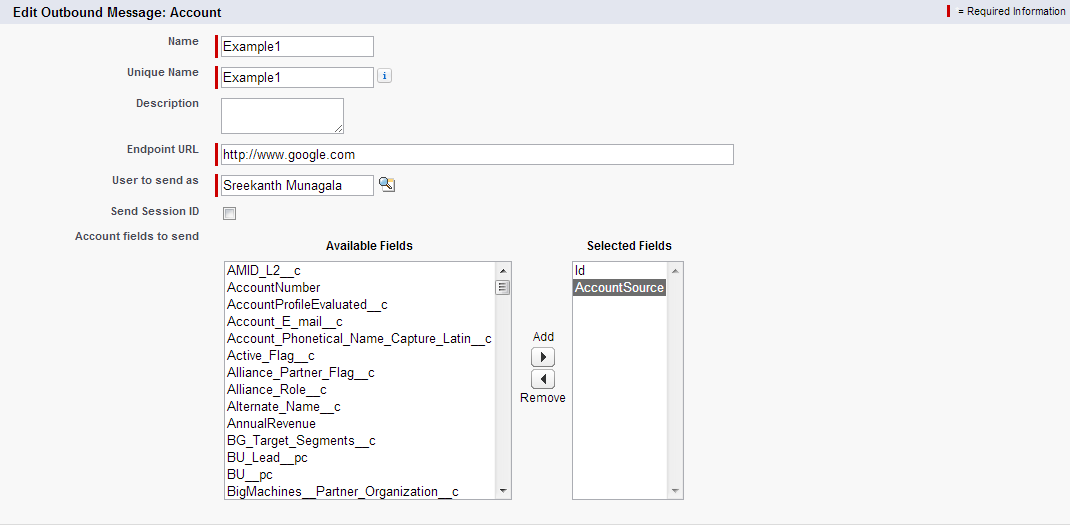
Select Existing Action to select an existing action to associate with the rule
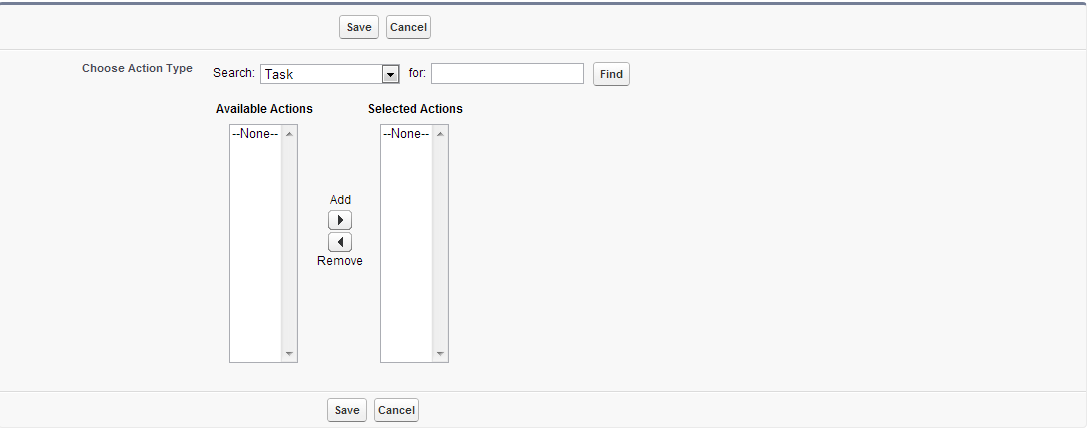
For Time-Dependent Workflow Actions workflow action
Click on Add Time Trigger
Specify a number of days or hours before or after a date relevant to the record, such as the date the record was created or modified.
Click on Save.

4) Configure additional immediate or time-dependent actions.
5) Click Done and Activate the workflow.
Latest updates in Salesforce Workflow Automation
Certainly! Here’s a well-structured and readable update on Salesforce Workflow Automation, using headings, subheadings, lists, small paragraphs, and a table for clarity.
Latest Updates in Salesforce Workflow Automation
Salesforce has introduced powerful updates to streamline automation, focusing on enhanced usability, cross-platform integration, and AI-driven insights. Here’s a look at the most recent advancements:
Overview of Key Features
| Feature | Description | Benefit |
|---|---|---|
| Flow as Core Automation Tool | Flow replaces Workflow Rules and Process Builder | Simplified automation setup and maintenance |
| Flow Orchestrator Enhancements | Multi-user, multi-step orchestration with intelligent recommendations | Streamlines complex workflows |
| MuleSoft Composer Integration | No-code integration across platforms like Slack and ServiceNow | Reduces dependency on IT |
| Einstein Automate Updates | AI-driven suggestions, predictive analytics, and Next Best Action | Enhances decision-making and proactive management |
| Screen Flow Improvements | Mobile optimization and dynamic forms for a better user experience | Increased usability for mobile users |
| Slack Real-time Integrations | Automated actions and updates directly within Slack | Improved team communication and collaboration |
| Enhanced Debugging and Testing | New testing framework and detailed error messages | Reduces deployment issues and troubleshooting time |
Core Updates and Their Benefits
1. Flow as the Core Automation Tool
Salesforce now positions Flow as the primary automation tool, encouraging users to move away from traditional Workflow Rules and Process Builder.
- Why the Change? Flow offers a unified platform for automation with greater functionality, supporting conditional logic, user interactions, and faster performance.
- New Tool: Flow Trigger Explorer: Enables users to manage all flows triggered by an object in a single view, making it easier to control and optimize workflow.
2. Flow Orchestrator Enhancements
Salesforce has upgraded Flow Orchestrator to support complex, multi-user, and multi-step processes.
Key Enhancements:
- Pre-built Templates: Templates for common workflows, such as approvals, simplify setup.
- Multi-user Coordination: Enables orchestration across departments, ideal for organization-wide workflows.
- Intelligent Recommendations: Based on user history, Flow Orchestrator can suggest configurations, expediting the design process.
3. MuleSoft Composer for Salesforce Integration
With MuleSoft Composer, Salesforce users can connect Salesforce to third-party systems easily, enabling data flow across platforms without the need for code.
Highlights:
- No-code Integration: Allows admins to automate across platforms like Slack, ServiceNow, and Workday without coding.
- Pre-built Connectors: Facilitates rapid setup for common applications, helping data flow seamlessly between systems.
4. Einstein Automate Updates
The AI-driven Einstein Automate suite now includes more robust features to assist with predictive and proactive decision-making.
- Next Best Action: Offers intelligent suggestions based on real-time data, enhancing workflow efficiency.
- Predictive Analytics: Einstein Automate leverages historical data to forecast outcomes, helping teams address issues proactively.
5. Auto-launched Flow Enhancements
Auto-launched flows have been upgraded for better timing and load management.
- Scheduled Paths: Define time-based triggers for tasks, reminders, and follow-ups.
- Asynchronous Paths: Separate immediate actions from delayed actions within a flow, improving response times and performance.
6. Screen Flow Improvements
Screen Flows, which allow user interaction within flows, have received improvements for a more customizable experience.
Key Features:
- Dynamic Forms: Fields adjust based on user inputs, delivering a more responsive interface.
- Mobile Optimization: Enhancements ensure Screen Flows display seamlessly across mobile devices, improving usability for on-the-go teams.
7. Enhanced Debugging and Testing Tools
Salesforce has added robust testing and debugging tools to improve flow reliability and deployment quality.
- Flow Testing Framework: Simulate different scenarios and validate outcomes to ensure smooth deployment.
- Improved Error Messaging: Detailed messages help users pinpoint and fix issues faster.
8. Real-time Slack Workflow Integrations
Salesforce’s integration with Slack has been strengthened, allowing for real-time updates and actions within Slack itself.
- Slack Action Triggers: Automate record creation, case updates, and notifications in response to specific Slack events.
- Automated Notifications: Automated messages within Slack keep teams informed on project statuses, approvals, and updates.
Summary: Why These Updates Matter
Salesforce’s recent workflow automation updates are designed to improve operational efficiency and reduce time spent on repetitive tasks. With powerful integrations, AI-driven insights, and enhanced debugging capabilities, Salesforce makes it easier for users to manage even the most complex workflows with minimal coding.
Takeaway: These updates offer significant time-saving and cross-functional collaboration benefits, empowering businesses to streamline processes and improve overall productivity.